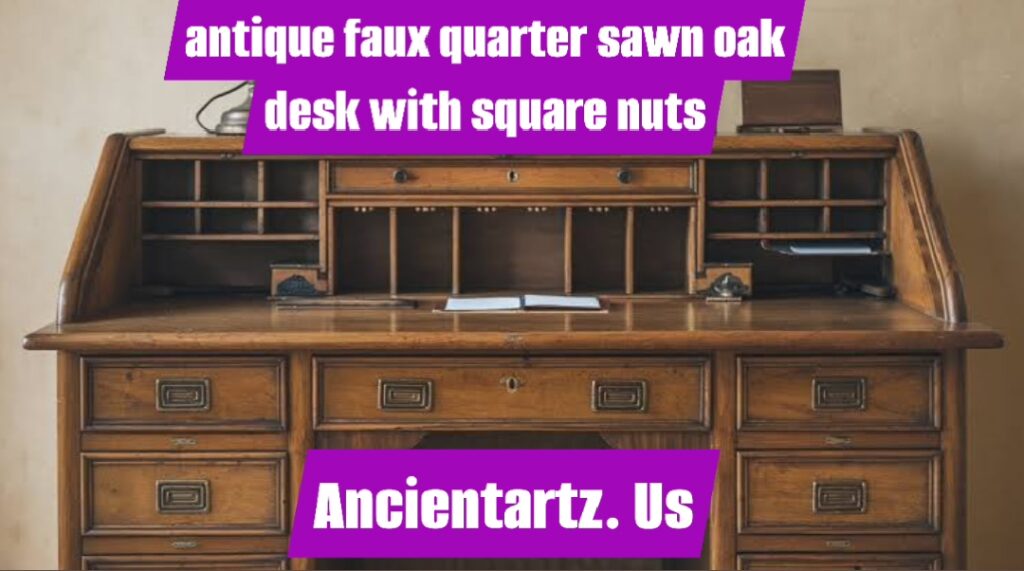Introduction:
The antique faux quarter sawn oak desk with square nuts with square nuts stands as an iconic piece of furniture that not only serves as a functional workspace but also tells a story of craftsmanship, history, and design. Quarter sawn oak is known for its unique appearance and durability, while the square nuts add an industrial touch to the piece, combining the beauty of antique furniture with the sturdiness required in modern-day furniture. This desk brings together a rich legacy of fine woodworking and artistic elegance, offering a timeless blend of aesthetics and practicality.
In the world of antique furniture, oak has long been considered one of the most reliable and durable woods used in the creation of lasting pieces. The quarter sawn technique, a process that involves cutting the oak logs radially, reveals the wood’s unique grain patterns, adding a sophisticated touch to any piece. The faux quarter sawn finish, while not made using the traditional method, still mimics these stunning grain patterns, making it a more affordable yet equally beautiful alternative.
In addition to the wood’s visual appeal, the square nuts in the desk add a distinctive feature that aligns with the industrial design movements of the late 19th and early 20th centuries. These square nuts are not just functional components that hold the desk together but also serve as a visual contrast to the smooth, polished surfaces of the wood. This juxtaposition of rough industrial elements and fine woodwork results in a fascinating synergy that defines the look and feel of this desk.
In this article, we will explore the unique features of the antique faux quarter sawn oak desk with square nuts. We will delve into its historical context, craftsmanship, the materials used, and how this piece has evolved over time. Additionally, we will look at the functionality and aesthetic appeal of this piece in modern settings, providing insight into why it remains an enduring favorite among antique enthusiasts and collectors alike.
The Allure of Quarter Sawn Oak and Faux Quarter Sawn Techniques
Oak has always been revered for its exceptional strength, durability, and versatility in furniture-making. When it comes to antique furniture, few woods are as cherished as quarter sawn oak. The quarter sawing technique, in which the oak log is cut into quarters and then sliced radially, produces an extraordinary grain pattern that is often referred to as “tiger-stripe” or “ray fleck.” This visually striking pattern has become one of the hallmarks of high-quality oak furniture and is often associated with American Arts and Crafts movement designs, such as those of Gustav Stickley and Frank Lloyd Wright.
However, not every piece of furniture is crafted with true quarter sawn oak, especially in mass production. The faux quarter sawn oak technique aims to replicate the distinctive appearance of quarter sawn oak but at a more affordable price point. This is achieved by cutting the wood in such a way that it mimics the grain patterns of true quarter sawn oak, although the cutting method is different. Faux quarter sawn oak retains much of the visual allure of its more expensive counterpart, making it a highly desirable material for crafting beautiful antique-style furniture at a more accessible cost.
antique faux quarter sawn oak desk with square nuts, although not made with the traditional quarter sawing process, still benefits from this technique’s elegant grain patterns and warmth. Its appearance is characterized by linear, shimmering streaks that run parallel to the wood’s grain, which create a dynamic, shimmering effect under light. The wood’s rich, golden-brown tones, paired with the intricate detailing, give the desk an aura of both sophistication and rustic charm.
Square Nuts: A Nod to Industrial Design
One of the most distinctive features of the antique faux quarter sawn oak desk with square nuts is the use of square nuts in its construction. While square nuts are primarily functional, serving as fasteners for connecting different parts of the desk, they also contribute a design element that adds to the overall aesthetic. Square nuts, unlike their round counterparts, are an industrial design choice that has become synonymous with furniture from the early 20th century.
The industrial design movement, which gained momentum during the late 19th and early 20th centuries, focused on blending raw, unrefined materials with clean lines and functionality. Square nuts, often used in the construction of machinery and industrial furniture, reflect this emphasis on utility and simplicity. Their angular shape contrasts beautifully with the smooth curves and polished surfaces of the quarter sawn oak, creating a visually intriguing juxtaposition between the organic and the mechanical.
In antique furniture, the presence of square nuts can also indicate the piece’s origin, as they were commonly used in the construction of Mission-style and Arts and Crafts furniture. This design approach was intentional, aiming to showcase the raw beauty of materials without excessive ornamentation. The square nuts on the faux quarter sawn oak desk, therefore, are not merely structural elements—they are symbolic of a design philosophy that values craftsmanship and honest, unadorned beauty.
Moreover, the square nuts add a touch of ruggedness to the desk, making it more suitable for a variety of environments. Whether placed in a study, office, or library, the desk exudes a sense of strength and reliability, reinforced by the square nuts that hold it together. The combination of rustic oak and industrial hardware gives the piece a versatile character that can blend seamlessly with both traditional and modern interiors.
Craftsmanship and Construction
The craftsmanship behind the antique faux quarter sawn oak desk with square nuts with square nuts is an integral part of what makes this piece so special. Every detail, from the shaping of the legs to the precision with which the square nuts are fastened, speaks to a level of artistry and attention to detail that is rarely seen in contemporary furniture.
The desk is typically constructed using a combination of traditional handcrafting techniques and more modern machinery, ensuring that it is both sturdy and aesthetically pleasing. The use of solid oak, particularly the faux quarter sawn variety, gives the piece both weight and structural integrity. The wood is carefully sanded and polished to bring out its natural beauty, with the grain patterns being a focal point of the design.
The square nuts, often made of brass or steel, are used to fasten the various components of the desk. These nuts are meticulously chosen to complement the overall design, with the texture of the metal providing an interesting contrast to the wood’s smooth finish. The precision with which these square nuts are applied ensures that the desk is not only functional but also a work of art. The craftsmanship in the construction of the desk, combined with the faux quarter sawn oak and square nuts, results in a piece that feels timeless and substantial.
Antique Furniture: A Rich Legacy
Antique furniture, particularly pieces made from oak, holds a special place in the world of interior design and collecting. The antique faux quarter sawn oak desk with square nuts carries with it the weight of history and tradition. It is a product of a bygone era when furniture was made to last, with a level of care and craftsmanship that is often lost in today’s mass-produced pieces.
Many of these desks were created in the late 19th to early 20th century, a time when industrialization was transforming the world. The Arts and Crafts movement, which emphasized handcrafted furniture and simple, functional design, was at its peak during this period. The antique faux quarter sawn oak desk with square nuts is an embodiment of this movement, combining the best elements of craftsmanship with the functional requirements of everyday life.
Antique furniture is not merely a decorative element; it is a statement of timeless style and lasting value. An antique desk, like the faux quarter sawn oak desk, represents a connection to the past. Its wear and patina tell a story of previous owners, of lives lived, and of its place in history. Collecting antique furniture is not only about acquiring beautiful objects but also about preserving a piece of cultural heritage for future generations.
Conclusion: The Enduring Appeal of the Faux Quarter Sawn Oak Desk
In conclusion, the antique faux quarter sawn oak desk with square nuts is a remarkable piece of furniture that combines artistry, history, and craftsmanship into a functional, enduring design. The faux quarter sawn oak, with its stunning grain patterns and warm tones, offers the beauty of traditional oak without the high cost. The square nuts, with their industrial design appeal, add a distinctive touch that enhances the desk’s character, making it a piece that stands out in any room.
The craftsmanship that goes into the construction of these desks reflects a commitment to quality that is often absent in modern, mass-produced furniture. The use of solid oak, the careful detailing of the square nuts, and the overall design come together to create a piece that is not only aesthetically pleasing but also built to last. Whether used in a home office, study, or library, the faux quarter sawn oak desk serves as both a functional workspace and a statement of timeless elegance.
The legacy of antique furniture continues to endure, and pieces like the faux quarter sawn oak desk with square nuts ensure that this tradition will live on for generations to come. As the world continues to evolve, the allure of antique craftsmanship, combined with the charm of functional design, ensures that these desks will remain cherished objects in homes and collections worldwide.
Frequently Asked Questions (FAQs)
- What is faux quarter sawn oak? Faux quarter sawn oak is a wood treatment that mimics the look of traditional quarter sawn oak without using the same cutting technique. The result is a similar grain pattern, often referred to as “ray fleck,” but at a more affordable price point.
- What are square nuts, and why are they used in furniture? Square nuts are fasteners with a square shape that are used to connect pieces of furniture. They are often used in antique furniture to add a touch of industrial design and provide a sturdy, reliable connection between parts.
- How can I care for my antique faux quarter sawn oak desk? To care for your antique faux quarter sawn oak desk, it is essential to regularly dust the surface with a soft cloth, avoid direct sunlight, and use furniture polish or wax to maintain its shine. Be cautious of placing heavy objects on the desk to prevent damage.
- What is the value of an antique faux quarter sawn oak desk? The value of an antique faux quarter sawn oak desk can vary depending on factors such as its age, condition, craftsmanship, and rarity. It is recommended to have the piece appraised by a professional to determine its current market value.
- Can I incorporate this desk into modern interiors? Absolutely! The antique faux quarter sawn oak desk with square nuts can blend beautifully with modern decor, especially in environments that embrace both rustic and industrial design elements. Its timeless appeal allows it to complement a wide range of interior styles.
Also Read This: Antique Faux Quarter Sawn Oak Desk with Square Nuts: A Timeless Piece of Craftsmanship


